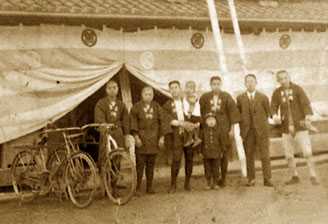Kongō Gumi
| Native name | 株式会社金剛組 |
|---|---|
| Romanized name | Kongō Gumi |
| Type | Kabushiki Gaisha |
| Industry | Construction |
| Fate | Acquired |
| Founded | 578 |
| Headquarters | Osaka, Japan |
| Parent | Takamatsu Corporation |
Kongō Gumi Co., Ltd. (株式会社金剛組 Kabushiki Gaisha Kongō Gumi) is a Japanese construction company which was the world's oldest continuously ongoing independent company, operating for over 1,400 years until it was absorbed as a subsidiary of another larger construction company. Headquartered in Osaka, the once family-owned construction company traced its origins to 578 when one of the skilled immigrants, whom Prince Shōtoku brought from Baekje to Japan to build the Buddhist temple Shitennō-ji, decided to start his own business. Over the centuries, Kongō Gumi participated in the construction of many famous buildings, including the 16th century Osaka Castle.
A three meter 17th-century scroll traces the 40 generations back to the company's start. As with many distinguished Japanese families, sons-in-law often joined the clan and took the Kongō family name. Thus, through the years, the line has continued through either a son or a daughter.
The company fell on hard times and went into liquidation in January 2006.[1] Its assets were purchased by Takamatsu Corporation.[2][3] Before its liquidation, it had over 100 employees and annual revenue of ¥7.5 billion ($70 million) in 2005; it still specialized in building Buddhist temples. The last president was Masakazu Kongō, the 40th Kongō to lead the firm. As of December 2006, Kongō Gumi continues to operate as a wholly owned subsidiary of Takamatsu.
See also
References
- ↑ "The End of a 1,400-Year-Old Business". Businessweek. 2007-04-16. Retrieved 2012-11-23.
- ↑ (Japanese) Announcement of business transfer from Kongō Gumi Takamatsu Corporation IR Topics, 14 December 2005.
- ↑ "End of the Road for World's Oldest Firm" Digital Chosunilbo (English Edition), 15 December 2005.
External links
- Kongō Gumi(Japanese)
- Nikkei Special "Dawn of Gaia" vol.296 Jan 8, 2008(Japanese) - Introducing documentary program about reconstruction process of Kongo Gumi with Takamatsu(日経スペシャル「ガイアの夜明け」2008年1月8日放送 第296回)